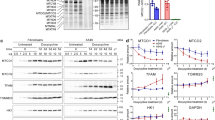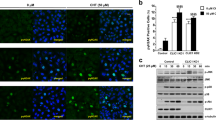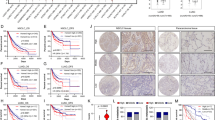Abstract
The CACNA2D2 gene, a new subunit of the Ca2+-channel complex, was identified in the homozygous deletion region of chromosome 3p21.3 in human lung and breast cancers. Expression deficiency of the CACNA2D2 in cancer cells suggests a possible link of it to Ca2+ signaling in the pathogenesis of lung cancer and other cancers. We investigated the effects of overexpression of CACNA2D2 on intracellular Ca2+ contents, mitochondria homeostasis, cell proliferation, and apoptosis by adenoviral vector-mediated wild-type CACNA2D2 gene transfer in 3p21.3-deficient nonsmall cell lung cancer cell lines. Exogenous expression of CACNA2D2 significantly inhibited tumor cell growth compared with the controls. Overexpression of CACNA2D2 induced apoptosis in H1299 (12.5%), H358 (13.7%), H460 (22.3%), and A549 (50.1%) cell lines. Levels of intracellular free Ca2+ were elevated in AdCACNA2D2-transduced cells compared with the controls. Mitochondria membrane depolarization was observed prior to apoptosis in Ad-CACNA2D2 and Adp53-transduced H460 and A549 cells. Release of cyt c into the cytosol, caspase 3 activation, and PARP cleavage were also detected in these cells. Together, these results suggest that one of the pathways in CACNA2D2-induced apoptosis is mediated through disruption of mitochondria membrane integrity, the release of cyt c, and the activation of caspases, a process that is associated with regulation of cytosolic free Ca2+ contents.
This is a preview of subscription content, access via your institution
Access options
Subscribe to this journal
Receive 50 print issues and online access
$259.00 per year
only $5.18 per issue
Buy this article
- Purchase on Springer Link
- Instant access to full article PDF
Prices may be subject to local taxes which are calculated during checkout






Similar content being viewed by others
Abbreviations
- ADP:
-
adenosinediphosphate
- CACNA2D2:
-
calcium-channel alfa-2-delta-2 subunit
- COX IV (I):
-
cytochrome oxidase IV subunit I
- cyt C:
-
cytochrome C
- DAPK:
-
death-associated protein kinase
- DMSO:
-
dimethylsulfoxide
- FBS:
-
fetal bovine serum
- HBSS:
-
Hanks balanced saline solution
- MOI:
-
multiplicity of infection
- NSCLC:
-
non-small cell lung cancer
- PARP:
-
poly ADP-ribose polymerase
- PI:
-
propidiumiodide
- TUNEL:
-
terminal deoxynucleotidyl transferase-mediated dUTP nick-end labeling
- VACC:
-
voltage-activated calcium channel
- XTT:
-
sodium 3,3′-{1-[(phenylamino)carbonyl]-3,4-tetrazolium}-bis(4-methoxy-6-nitro)-benzene sulfonic acid hydrate
- wt:
-
wild-type
References
Angeloni D, Wei MH, Duh FM, Johnson BE and Lerman MI . (2000). Mol. Cell Probes, 14, 53–54.
Ankarcrona M, Dypbukt JM, Bonfoco E, Zhivotovsky B, Orrenius S, Lipton SA and Nicotera P . (1995). Neuron., 15, 961–973.
Barclay J, Balaguero N, Mione M, Ackerman SL, Letts VA, Brodbeck J, Canti C, Meir A, Page KM, Kusumi K, Perez-Reyes E, Lander ES, Frankel WN, Gardiner RM, Dolphin AC and Rees M . (2001). J. Neurosci., 21, 6095–6104.
Berridge MJ, Bootman MD and Lipp P . (1998). Nature, 395, 645–648.
Berridge MJ, Lipp P and Bootman MD . (2000). Nat. Rev. Mol. Cell. Biol., 1, 11–21.
Brown JP and Gee NS . (1998). J. Biol. Chem., 273, 25458–25465.
Burgess DL, Davis CF, Gefrides LA and Noebels JL . (1999). Genome Res., 9, 1204–1213.
Castellano A, Wei X, Birnbaumer L and Perez-Reyes E . (1993). J. Biol. Chem., 268, 3450–3455.
Catterall WA . (2000). Annu. Rev. Cell Dev. Biol., 16, 521–555.
Chen Q, Gong B and Almasan A . (2000). Cell Death Differ., 7, 227–233.
Cossarizza A, Cooper EL, Quaglino D, Salvioli S, Kalachnikova G and Franceschi C . (1995). Biochem. Biophys. Res. Commun., 214, 503–510.
Desagher S and Martinou JC . (2000). Trends Cell Biol., 10, 369–377.
Felix R . (1999). Receptors Channels, 6, 351–362.
Fondon JW, Mele GM, Brezinschek RI, Cummings D, Pande A, Wren J, O'Brien KM, Kupfer KC, Wei MH, Lerman M, Minna JD and Garner HR . (1998). Proc. Natl. Acad. Sci. USA, 95, 7514–7519.
Gao B, Sekido Y, Maximov A, Saad M, Forgacs E, Latif F, Wei MH, Lerman M, Lee JH, Perez-Reyes E, Bezprozvanny I and Minna JD . (2000). J. Biol. Chem., 275, 12237–12242.
Gross A, McDonnell JM and Korsmeyer SJ . (1999). Genes Dev., 13, 1899–1911.
Hobom M, Dai S, Marais E, Lacinova L, Hofmann F and Klugbauer N . (2000). Eur. J. Neurosci., 12, 1217–1226.
Hofmann F, Lacinova L and Klugbauer N . (1999). Rev. Physiol. Biochem. Pharmacol., 139, 33–87.
Hurley JH, Cahill AL, Currie KP and Fox AP . (2000). Proc. Natl. Acad. Sci. USA, 97, 9293–9298.
Ji L, Fang B, Yen N, Fong K, Minna JD and Roth JA . (1999). Cancer Res., 59, 3333–3339.
Kao JP, Harootunian AT and Tsien RY . (1989). J. Biol. Chem., 264, 8179–8184.
Klugbauer N, Lacinova L, Marais E, Hobom M and Hofmann F . (1999). J. Neurosci., 19, 684–691.
Kochegarov AA, Beylina SI, Matveeva NB, Leontieva GA and Zinchenko VP . (2001). Comparative Biochem. Physiol. 128(Part A), 279–288.
Kroemer G and Reed JC . (2000). Nat. Med., 6, 513–519.
Lacinova L, Klugbauer N and Hofmann F . (2000). Gen. Physiol. Biophys., 19, 121–136.
Lam M, Dubyak G, Chen L, Nunez G, Miesfeld RL and Distelhorst CW . (1994). Proc. Natl. Acad. Sci. USA, 91, 6569–6573.
Lemasters JJ, Nieminen AL, Qian T, Trost LC, Elmore SP, Nishimura Y, Crowe RA, Cascio WE, Bradham CA, Brenner DA and Herman B . (1998). Biochim. Biophys. Acta., 1366, 177–196.
Lerman MI and Minna JD . (2000). Cancer Res., 60, 6116–6133.
Marais E, Klugbauer N and Hofmann F . (2001). Mol. Pharmacol., 59, 1243–1248.
Martinou JC and Green DR . (2001). Nat. Rev. Mol. Cell Biol., 2, 63–67.
Nishizaki M, Meyn RE, Levy LB, Atkinson EN, White RA, Roth JA and Ji L . (2001). Clin. Cancer Res., 7, 2887–2897.
Raveh T and Kimchi A . (2001). Exp. Cell Res., 264, 185–192.
Reed JC and Kroemer G . (2000). Cell Death Differ., 7, 1145.
Rutter GA and Rizzuto R . (2000). Trends Biochem. Sci., 25, 215–221.
Singer D, Biel M, Lotan I, Flockerzi V, Hofmann F and Dascal N . (1991). Science, 253, 1553–1557.
Toyota M, Ho C, Ohe-Toyota M, Baylin SB and Issa JP . (1999). Cancer Res., 59, 4535–4541.
Ueki T, Toyota M, Sohn T, Yeo CJ, Issa JP, Hruban RH and Goggins M . (2000). Cancer Res., 60, 1835–1839.
Varadi G, Strobeck M, Koch S, Caglioti L, Zucchi C and Palyi G . (1999). Crit. Rev. Biochem. Mol. Biol., 34, 181–214.
Vieira HL, Haouzi D, El Hamel C, Jacotot E, Belzacq AS, Brenner C and Kroemer G . (2000). Cell Death Differ., 7, 1146–1154.
von Ahsen O, Waterhouse NJ, Kuwana T, Newmeyer DD and Green DR . (2000). Cell Death Differ., 7, 1192–1199.
Walker D and De Waard M . (1998). Trends Neurosci., 21, 148–154.
Wang HG, Pathan N, Ethell IM, Krajewski S, Yamaguchi Y, Shibasaki F, McKeon F, Bobo T, Franke TF and Reed JC . (1999a). Science, 284, 339–343.
Wang M, Offord J, Oxender DL and Su TZ . (1999b). Biochem. J., 342, 313–320.
Zhu L, Ling S, Yu XD, Venkatesh LK, Subramanian T, Chinnadurai G and Kuo TH . (1999). J. Biol. Chem., 274, 33267–33273.
Zhu LP, Yu XD, Ling S, Brown RA and Kuo TH . (2000). Cell Calcium, 28, 107–117.
Zochbauer-Muller S, Fong KM, Virmani AK, Geradts J, Gazdar AF and Minna JD . (2001). Cancer Res., 61, 249–255.
Acknowledgements
The authors would like to thank Karen Ramirez and Wendy Schober-Ditmore for their assistance in FACS analysis, and David McConkey, Leta Nutt, and Abujiang Pataer for discussions on the methodology. This work was partially supported by grants from the National Cancer Institute, the National Institutes of Health SPORE (2P50-CA70907-04); (P01 CA78778-01A1) (JAR); (CA71618) (JDM), a WM Keck Gene Therapy Career Development Grant (LJ), by a grant from the Department of the Army BESCT Lung Cancer Program (DAMD17011068902); by the Swiss National Science Foundation (GLC) and Bernische Krebsliga (GLC); by gifts to the Division of Surgery MD Anderson Cancer Center, from Tenneco and Exxon for the Core Laboratory Facility; by the M. D. Anderson Cancer Center Support Core Grant (CA16672); by a grant from the Tobacco Settlement Funds as appropriated by the Texas State Legislature (Project 8), and by a sponsored research agreement with Introgen Therapeutics, Inc. (SR93-004-1).
Author information
Authors and Affiliations
Corresponding author
Rights and permissions
About this article
Cite this article
Carboni, G., Gao, B., Nishizaki, M. et al. CACNA2D2-mediated apoptosis in NSCLC cells is associated with alterations of the intracellular calcium signaling and disruption of mitochondria membrane integrity. Oncogene 22, 615–626 (2003). https://doi.org/10.1038/sj.onc.1206134
Received:
Revised:
Accepted:
Published:
Issue Date:
DOI: https://doi.org/10.1038/sj.onc.1206134
Keywords
This article is cited by
-
Global DNA methylation pattern involved in the modulation of differentiation potential of adipogenic and myogenic precursors in skeletal muscle of pigs
Stem Cell Research & Therapy (2020)
-
The Risk for Lung Cancer Incidence with Calcium Channel Blockers: A Systematic Review and Meta-Analysis of Observational Studies
Drug Safety (2018)
-
CACNA2D2 promotes tumorigenesis by stimulating cell proliferation and angiogenesis
Oncogene (2015)
-
Isolation and characterization of the 5´-upstream region of the human voltage-gated Ca2+ channel α2δ-1 auxiliary subunit gene: promoter analysis and regulation by transcription factor Sp1
Pflügers Archiv - European Journal of Physiology (2013)
-
Methylation of the calcium channel regulatory subunit α2δ-3 (CACNA2D3) predicts site-specific relapse in oestrogen receptor-positive primary breast carcinomas
British Journal of Cancer (2012)



